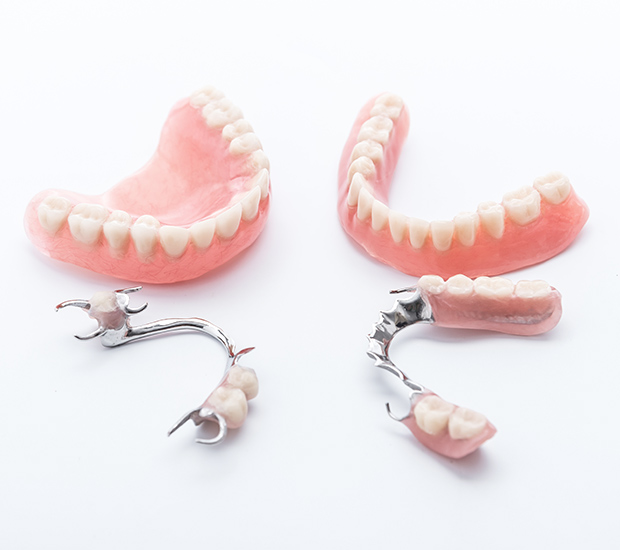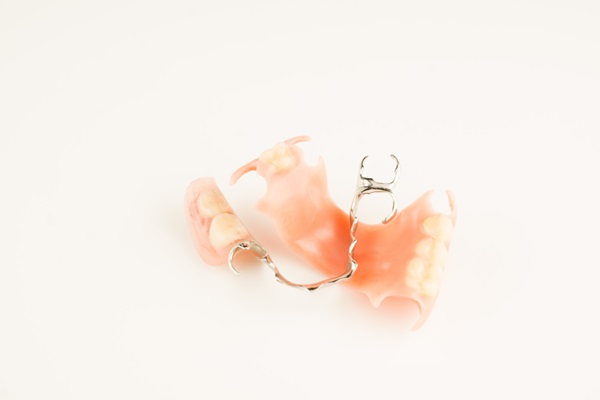Dentures and Partial Dentures Georgetown, TX
When it comes to lost teeth, there are many practical replacement options to restore one's smile. Missing teeth are not just a question of appearance; they also affect the health of the remaining teeth as well as everyday comfort. Dentures and partial dentures are popular tooth replacement options that are customized for an optimal fit.
Dentures and partial dentures are available at Healthy Smiles Dentistry Georgetown in Georgetown and the surrounding area. We use high-quality materials and advanced fitting techniques to support your comfort and dental health. With our help, you can select the type of denture that will work for you.
Get in touch today by calling us at (512) 864-9010 to discuss how dentures can improve your quality of life.
Reasons to Get Dentures
While there are other options available, there are several reasons that so many people turn to dentures:
- Denture may be an affordable solution to tooth loss. Other tooth replacement options tend to cost more, contingent upon the insurance provider. Traditional full dentures and partial dentures are typically more cost-efficient than alternatives. This is true even when factoring in the cost of replacing the dentures every 5-10 years.
- Lower risk associated with denture procedure. The patient prefers to avoid the potentially painful failure risk associated with bridges. Dental implants also require more invasive surgery, by nature making them riskier. Age and potential bone loss can increase risk.
- Denture can be received relatively quickly. Dentures typically take less time to receive than implants. Dental implants may take a year or more to complete. Healing periods between steps may last for up to six months.
Check out what others are saying about our denture and partial denture services on Yelp: Dentures and Partial Dentures Georgetown
How Dentures Are Made
Dentures consist of a flesh-colored base and the synthetic teeth attached to it. Today, both components are made of a type of acrylic. The artificial teeth are typically made of acrylic resin, which closely approximates the appearance of real teeth.
Once the decision is made to proceed with dentures, the patient will make an appointment for the impression. The dentist will put a tray with a thick paste into the patient's mouth to take impressions of the upper and lower teeth. This process usually takes about 20 seconds for each impression. The dentist may offer to apply a numbing agent to the palate beforehand to minimize discomfort.
Afterward, the impressions are used to make a plaster model of the mouth. The dental lab technician then uses wax to attach the teeth. The wax is shaped and trimmed according to the patient's gum shape.
Then the wax shape with attached teeth is placed in a container, sometimes called a flask. Dental stone or plaster is poured around to hold it. The wax is then boiled out, leaving a molding in the shape of the gums, and the acrylic material for the dentures' base is poured in.
The denture is removed from the container, trimmed and polished. At this point, the patient will have the first fitting. While some people may find their dentures fit properly right away, most need to have a few adjustments done for optimal comfort.
It is normal to need several fitting appointments before the dentures fit the way they should. Patients should not hesitate to let the dentist know if something feels wrong. What may seem like a trivial amount of discomfort during fitting can seriously interfere with your quality of life, later on, so be sure to speak up.
Types of Dentures
There are several basic types of dentures. The right option for you can depend on several factors, which Healthy Smiles Dentistry Georgetown can discuss with you. Choosing an option that works for you can help you get the most out of the dentures.
Dentures can be full or partial. A full set can be necessary for patients who are missing all their teeth. In this case, impressions will be taken of the gums and the teeth made to maintain the proportions and distances similar to the real teeth. A partial set can be an option if the patient still has several teeth in good condition remaining.
Additionally, there are also fully removable and bridge-supported dentures. Removable dentures are what most people picture: the base that sits on the gums with attached teeth. They can be easily taken out. While this option is typically more affordable, removable dentures may need several adjustments over the years as the mouth's shape changes.
Bridge-supported dentures are also removable but do not have a base. They are clipped on to four or six dental implants. These implants are small titanium posts that are surgically inserted into the jawbone. Eventually, the implants fuse with the bone.
Due to the implants, bridge-supported dentures tend to be more costly than other options. They also involve minor surgery. However, many people find they feel more secure and are more comfortable because they do not need a base. The implant procedure can also reduce future bone loss, which can be familiar with missing teeth.
Not all patients are good candidates for fixed dentures. Those who already suffer extensive bone loss may not have enough bone to support the implants. Some other health concerns can also prevent implants from being a good option.
Options Other Than Dentures and Partial Dentures
Dentures have been improved in design for over a hundred years. Today they are a viable option for patients of all ages, whether one tooth needs to be replaced or many. At Healthy Smiles Dentistry Georgetown, we can advise patients on when this treatment would suit their oral health needs. At our office, we can also advise you on other options for replacing missing teeth. Each type of tooth replacement has distinguishing qualities. There are two primary categories of tooth replacement other than dentures:
- Dental implants. These are artificial teeth similar in look and feel to natural teeth. They have roots made with screws that are inserted into the jaw for stability. Implants are highly durable with the capacity to last a lifetime with proper care.
- Dental bridge. A bridge closes the space left by missing teeth; hence, why they are referred to as “bridges.” Bridges are held in place by either natural teeth or implants with artificial teeth bridging the space and two or more crowns placed over the teeth and connected to an artificial tooth.
How to Care for Dentures
Dentures do require ongoing maintenance outside of the typical oral hygiene routine. Many people believe they can set dentures down by the side of the bed. However, this can lead to warping and cracking over time.
Instead, patients should soak dentures overnight. Avoid hot water, as this may also cause warping. Patients who use denture solutions should rinse thoroughly before replacing as denture solutions should not be ingested. Our team can recommend if solution is right for your regimen. Remember never to use these directly in the mouth, either.
It is also important to note that dentures require cleaning, just like regular teeth do. Whenever possible, remove dentures after eating or drinking and rinse them to get rid of food particles. Patients should also brush dentures at least once per day. Dentists recommend a soft-bristled brush as a more abrasive brush may cause damage over time.
Even if no teeth remain, continued dental hygiene is essential. Brush the teeth and gums and floss any remaining teeth. Patients may also use gauze or a soft toothbrush to clean the cheeks, roof of the mouth, and even the tongue. Finally, people who use adhesives should take care to remove this.
Common Misunderstandings About Dentures
There are many benefits and advantages to getting dentures. However, some prospective patients shy away from seeking this treatment because of myths and other false information. Some people do not know enough about dentures and how this treatment can benefit their oral health and the appearance of their face.
People often believe that dentures are the last resort when all other options have failed. The fact is that dentures are not nearly as invasive as other treatment options. Wearing dentures can preserve mouth function as well as any other option.
Another misconception is that it is easy to spot a pair of dentures in a person’s mouth. Dentures are natural-looking in the base with artificial teeth. We can help ensure that dentures or partial dentures blend in with the surrounding teeth. Also, while dentures can fall out at inopportune times, our dentist can suggest adhesive products to hold the appliance in place.
Questions Answered on This Page
Q. Are there different types of dentures?
Q. Are there dentures to replace a few of my teeth?
Q. What are the benefits of dentures?
People Also Ask
Q. How do I take care of my dentures?
Q. What do I do if I damage my dentures?
Q. What do I need to know about making adjustments to my dentures?
Definition of Denture Terminology
- Alveolar Bone
- The alveolar bone is the bone surrounding the root of the tooth that keeps the tooth in place.
- Clasp
- A clasp is a device that holds a removable partial denture prosthesis to the teeth.
- Denture Base
- The denture base is the part of the denture that connects the artificial teeth with the soft tissue of the gums.
- Edentulous
- Edentulous is a term that applies to people who do not have any teeth.
- Periodontal Disease
- Periodontal disease is a condition that causes inflammation of the gingival tissues and membrane of the teeth, leading to tooth loss without professional treatment.
- Pontic
- Pontic is another term for an artificial tooth on a fixed partial denture.
- Rebase
- Rebase is the process of refitting denture prosthesis by replacing the base material.
- Reline
- Reline is when a professional resurfaces the surface of the prosthesis with a new base material.
- Resin/Acrylic
- Resin and Acrylic are resinous materials that can be components in a denture base.
- Stomatitis
- Stomatitis is the inflammation of the tissue that is underlying a denture that does not fit properly. It can also result from other oral health factors.
Back to top of Artificial Teeth




